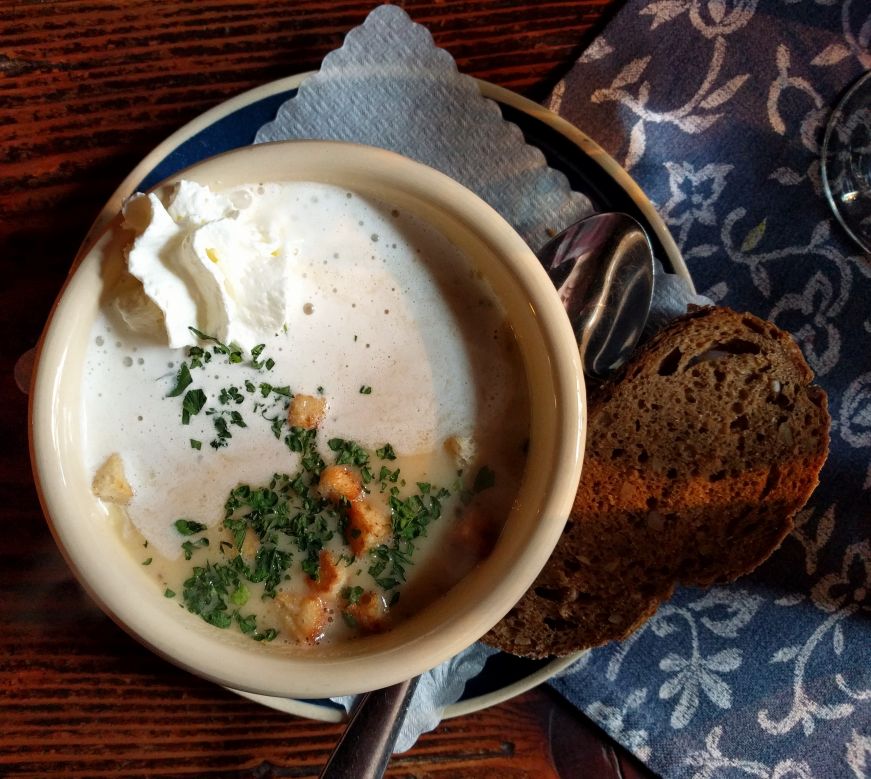Rothenburg ob der Tauber is Germany's best-preserved medieval town, a colorful jumble of half-timbered buildings completely encircled by a thick stone wall. The downside: the cobblestones of Rothenburg's picturesque streets are well-worn by the tourist masses. You'll probably hear more English and Japanese than German, and the historic part of town skews heavily towards tourist-centered commerce. If you're looking for a hidden gem, this isn't it. But here's my take: the things that make Rothenburg popular--the narrow lanes, the leaning medieval buildings, the masterpiece of a wooden altar in St. Jacob's Church, the gritty-but-hilarious Night Watchman's Tour--are also what make Rothenburg worthwhile.
We arrived in Rothenburg at lunch time, spent the afternoon and evening sightseeing, and then woke up early the next morning to get some tourist-free photos and walk atop the old town wall before breakfast. I definitely recommend spending the night in Rothenburg--since most tourists are day trippers, the town is less crowded and more enjoyable in the evening and early morning. The town is small (it takes less than 15 minutes to walk across the historic walled portion), so our itinerary gave us enough time for sightseeing. However, if you want to avail yourself of Rothenburg's excellent shopping opportunities--ranging from tourist kitsch to artisanal handicrafts--I recommend giving yourself a few additional hours. With more time, you could also visit the Medieval Crime and Justice Museum or the German Christmas Museum.
Note that Germany has several Rothenburgs, so make sure you book your train ticket to "Rothenburg ob der Tauber" (Rothenburg above the Tauber River).
What to eat:
Rothenburg's signature pastry is the Schneeball (snowball), made of strips of dough that are formed into a ball and deep-fried. Traditionally, they were dusted with confectioner's sugar (hence the "snowball" moniker), but today you can find gussied up versions dipped in chocolate, cinnamon sugar, nougat, strawberry icing, or even coconut. Schneeballen are sold at every bakery in town, with the largest selection at the bakeries and specialty shops along Ober Schmiedgasse, the main tourist drag. I loved them, but some find Scheeballen dry and flavorless--I think they mostly appeal to those of us who love pie crust and the crispy edges of wontons.

The most atmospheric dinner in town is at the Altfränkische Weinstube (Klosterhof 7)--the decor doesn't seem to have changed since the restaurant was built 650 years ago. Exposed beams crisscross the ceiling, tiny windows keep the light level romantically dim, and candles sputter on every table. Quarters are cozy, and our wooden table definitely wasn't designed for dinner plates of modern dimensions. If you're staying at the inn (more on that below), make a reservation for dinner when you check in, since the restaurant is small and popular.
The menu (which is available in English) offers classic southern German specialties with an elegant contemporary presentation. The sole vegetarian entree is the standard cheese spätzle (on this trip, I ate a great deal of cheese spätzle), so instead I opted for a salad topped with berries, kiwi, pineapple, smoked salmon and trout, and a whole crayfish. It sounds a bit odd, but a creamy mustard-dill dressing tied it all together. Mike started with a rich bowl of the housemade potato soup, garnished with generous dollop of unsweetened whipped cream, and then moved on to the cheese plate, an assortment of soft French and German cheeses served with fruit and rye bread.
What to see:
The main tourist attraction in Rothenburg is the town itself: spend a couple hours exploring around the compact walled town (the Rick Steves audio tour provides some excellent background information about the various buildings and Rothenburg's history). Rothenburg looks like something out of storybook, and was actually the model for the town in Disney's 1940 animated adaptation of Pinocchio. Start at the Market Square and pay the modest fee to climb the 214 steps to the top of the 200-foot Town Hall tower. Getting a bird's eye view from the tallest perch in town gives you a good orientation, especially for the irregular perimeter of the old town walls.
St. Jacob's Church is a soaring space that seems far too large for what was a town of only 6,000 people at its peak. Walk behind the main altar to admire the stained glass--the windows are original, and date to the 1330s. Then, climb the stairs at the back of church, leading up behind the pipe organ. This little chapel was added in the 16th century to accommodate the church's most important work, the Altar of the Holy Blood (when you go outside, you'll see that the chapel extends over the street). The intricate work took master woodcarver Tilman Riemenschneider several years to complete, and the detail and emotion on the figures' faces is moving to the faithful and non-believers alike. The center of the altar depicts the Last Supper, while the side panels and bottom the altar illustrate other parts of the Passion narrative. The altar was actually built to display a tiny scrap of cloth believed to be stained by Christ's blood--it's encased in crystal and set in the cross held aloft by two angels at the top of the altar.
After spending the day admiring the storybook buildings, the Night Watchman's Tour will disabuse you of any romantic notions about Rothenburg's past. The hour-long tour (offered in English at 8 pm, and German at 9:30 pm) is a blunt take on medieval life, with descriptions of the garbage-filled streets, chamber pots emptied out of windows, rats, plague, and plundering troops. However, the tour is far from depressing--the costumed night watchman, Hans Georg Baumgartner, has a Monty Python-style sense of humor, dark but entertaining. Tours are very low key: you just show up in front of the Town Hall by 8 pm and pay in cash at the end of the tour.
Since Rothenburg is beloved by tourists from around the world, you need to wake up early if you want to get pictures of the town without the crowds (i.e., the photos in this post) . Before breakfast, head over to the Market Square and stroll down Schmiedgasse for some picturesque, tourist-free photo opportunities. Then, climb up one of the towers and walk atop the old town wall--although most of the western section of the wall is inaccessible, you can walk on top of the entire northern and eastern sections. Even if you're not a photography buff, the narrow walkway is far more enjoyable when you have it completely to yourself.
Where to stay:
In addition to the lovely medieval-style restaurant mentioned above, the Altfränkische Weinstube (Klosterhof 7) has six guest rooms with medieval style and modern amenities. We stayed in room #2, which has a sloped half-timbered ceiling, chandelier, very comfortable four poster bed, and a large bathroom with a soaking tub. The WiFi is a bit spotty, but the romantic setting and excellent breakfast buffet made this our favorite hotel of the trip.
More posts about my trip to Germany:

Share your thoughts
I definitely would like the…
I definitely would like the Schneeball. The town looks amazing and the altar in St Jacobs is absolutely beautiful.
We both enjoyed the…
We both enjoyed the Schneeball too! Rothenburg was one of the highlights of our trip, I'd definitely recommend visiting if you're ever in Germany.